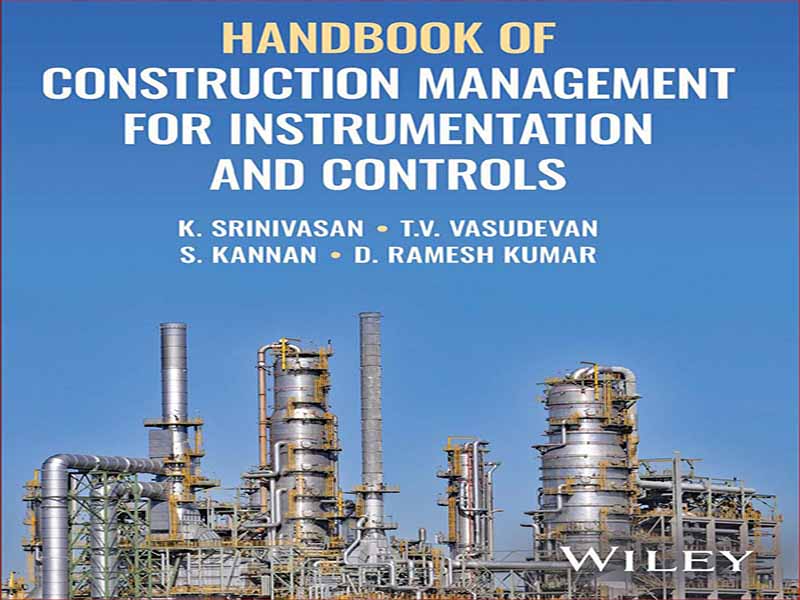- عنوان مجله: Handbook of Construction Management for Instrumentation and Controls
- نویسنده: K. Srinivasan
- حوزه: َابزار دقیق
- سال انتشار: 2024
- تعداد صفحه: 545
- زبان اصلی: انگلیسی
- نوع فایل: pdf
- حجم فایل: 43.4 مگابایت
ابزار دقیق برای صنایع فرآیندی در حال تکامل است، شاید سریعتر از بسیاری از فن آوری های دیگر. دقت و سرعتی که با آن داده های کارخانه در اختیار پرسنل قرار می گیرد، بسیار بیشتر از آنچه بود، حتی یک دهه قبل است. ظهور فناوری دیجیتال و پیشرفت های صورت گرفته در ارتباطات، انقلابی را به وجود آورده است. همراه با رایانههای مرتبط، گزارشهای مربوطه جزئیات مربوط به سطوح فعلی تولید، تنگناها، ذخایر مواد خام، سطح کالاهای نهایی و غیره را در اختیار اعضای هیئتمدیره و مدیران تولید قرار میدهد و آنها را قادر میسازد تا تصمیمات مناسب را تقریباً بهموقع اتخاذ کنند. با این حال، همه اینها به یک عامل کلیدی بستگی دارد – نصب و راه اندازی صحیح سیستم ابزار دقیق. همچنین اطمینان از قابلیت اطمینان طولانی مدت بدون خرابی های مکرر ضروری است. به عنوان مثال، هر شکلی از ابزار تجزیه و تحلیل، پیچیده یا غیره، تنها به اندازه سیستم نمونه گیری آن موثر است. فناوری دیجیتال و قابلیتهای ارتباطی امروزی، تغییراتی را در ساختارهای سازمان اداری و مدیریت اداری ایجاد کرده است. تغییرات مشابهی در مدیریت ساخت و ساز شروع خواهد شد. ساختارهای مدیریت سنتی، با مدیرانی که از روشها و سبکهایی بر اساس تجربیات قبلی خود در سایتهای دیگر استفاده میکنند، ممکن است ناکافی باشند. علاوه بر این، نصب، کالیبراسیون و آزمایش ابزارهای امروزی نیاز به مهارت ها و تجربیات متفاوتی دارد. تجربه در نصب و آزمایش تنها مهارت های مورد نیاز یک مدیر نصب ابزار سایت نیست، که شغل او نیازمند برنامه ریزی نیروی انسانی، استخدام، ایمنی سایت، حضور در جلسات، گزارش پیشرفت، مدیریت مواد، کنترل هزینه، مدیریت تغییر، مدیریت پایگاه داده است. ، مدیریت تاخیر، E.O.T. (تمدید زمان برای رسیدن به تکمیل)، مدیریت مقررات / فرم های دولتی و انبوهی از مسائل دیگر. در برابر این پس زمینه، ما با مجموعه جدیدی از مدارک مورد نیاز برای مدیر نصب ابزار سایت مواجه می شویم. با توجه به نیازهای فوق، این کتابچه اطلاعاتی در مورد تمام جنبه های مدیریت سایت همراه با جزئیات نصب، کالیبراسیون و آزمایش ابزارهای سنتی ارائه می دهد. 1) بخش 1 یک مقدمه کوتاه و یک نقشه راه برای کتاب راهنما ارائه می دهد. 2) بخش 2 در “مدیریت ساخت و ساز” فهرستی از اقداماتی که باید توسط مدیر نصب ابزار سایت انجام شود را خلاصه می کند. با مدیریت و کنترل سایت، مدیریت اسناد و کنترل هزینه سروکار دارد. این بخش همچنین شامل مدیریت پیمانکار فرعی، نقض قرارداد، پرداخت های پیشرفت، ادعاهای تاخیر، تمدید زمان، مستندات، گزارش های ایمنی سایت، و تکمیل و بسته شدن پروژه می شود. سیستم گزارش وقوع سایت معرفی شده است. 3) بخش 3 جزئیات نصب میدانی را مورد بحث قرار می دهد و توصیه هایی را در مورد نصب لوله ها، کابل ها، جعبه های اتصال، پایانه ها، شبکه های فیبر نوری، زمین، طرح های ارتینگ، و غیره ارائه می دهد. اتصالات خط ضربه ای به انواع مختلف خدمات مورد بحث قرار می گیرد. نصب تحلیلگر فرآیند برای وظایف مختلف ارائه شده است. جزئیات در مورد کالیبراسیون انواع مختلف ابزار، از جمله ابزار HART و Smart آورده شده است. سیستم های I&C اتاق کنترل و سیستم ها و تاسیسات مدیریت ساختمان مورد بحث قرار می گیرند. همچنین جزئیات مربوط به بستههای ویژه مانند – بستههای I&C کمپرسور، سیستمهای HVAC، اتوماسیون مخزن، سیستمهای پایانه محصول، اثبات کنتور و انتقال نگهداری و VSD ارائه شده است. برنامه های QA/QC نیز مورد بحث قرار گرفته است. در این بخش، رویههای بررسی حلقه (روشهایی که باید برای سیگنالهای آنالوگ و دیجیتال دنبال شوند) گنجانده شده است. تست های پذیرش سایت (SAT)، بررسی های قبل از راه اندازی و غیره شرح داده شده است. رهنمودهایی برای تنظیم حلقه پایه داده شده است. مراحل ثبت نام و تحویل مورد بحث قرار می گیرد. با مدیریت تغییر، حتی پس از یک تلاش طراحی دقیق، برخی از نظارت ها در طول مراحل طراحی ممکن است منجر به نیاز به ابزار دقیق اضافی شود. غیر معمول نیست که در طول مراحل راه اندازی، چنین الزامات اضافی ممکن است برجسته شود. در حالی که برخی از تغییرات ممکن است جزئی باشند، برخی دیگر ممکن است اینطور نباشند. همه تغییرات نیاز به زمان و پرسنل برای رسیدگی به آنها دارند. تغییرات همچنین ممکن است منجر به خرید بیشتر شود. علاوه بر این، در حالی که تغییرات در حال اجرا هستند، اسناد مرتبط نیاز به ارتقا دارند. اینها منجر به هزینه های اضافی می شود. این هندبوک روش هایی را برای مدیریت تغییر و هزینه یابی مرتبط ارائه می دهد. 4) بخش 4 مصالح ساختمانی انبوه را مورد بحث قرار می دهد. گاهی اوقات، برخی از اقلام مانند آفتابگیر، پایه و پلاک نام ممکن است نیاز به تولید یا تهیه برای استفاده در سایت داشته باشند. نقشه ها و مشخصات برخی از اقلام رایج در اینجا آورده شده است. مشخصات کابل ها نیز آورده شده است. 5) بخش 5 یک مجموعه اطلاعات مهندسی مفید برای ساخت و ساز I&C است (در واقع یک ضمیمه اطلاعات) که لیستی از استانداردهایی را ارائه می دهد که به طور کلی به آنها ارجاع می شود. همچنین استانداردهای مهندسی مفیدی برای ترموکوپل ها دارد.
Instrumentation for process industries is evolving, perhaps faster than most other technologies. The accuracy and speed at which plant data is made available to personnel is way ahead of what it was, even a decade back. The advent of digital technology and advances made in communication have enabled a revolution. Together with associated computers, relevant reports giving details on current production levels, bottlenecks, raw material stocks, finished goods levels, etc. are made available to board members and production executives, enabling them to take appropriate decisions almost on a real-time basis. Yet, all this depends on one key factor – correct installation and commissioning of the instrumentation system. It is also essential to ensure long-term reliability without frequent breakdowns. For example, any form of analysis instrument, sophisticated or otherwise, is only as effective as its sampling system. Digital technology and today’s communication capabilities have forced changes in office organization structures and office management. Similar changes will start happening in construction management. Traditional management structures, with managers using methods and styles based on their previous experiences at other sites, may be found to be inadequate. In addition, installation, calibration and testing of today’s instruments call for different skills and experiences. Experience in installation and testing are not the only skills needed from a site Instrument Installation Manager, whose job calls for man-power planning, recruitment, site safety, attendance in meetings, progress reporting, material management, cost control, change management, database management, delay management, E.O.T. (Extension-Of-Time for reaching completion), managing government regulations / forms and a host of other issues. Against this background, we come up with a new set of qualifications needed for a site Instrument Installation Manager. Addressing the above needs, this Handbook provides information on all aspects of site management together with details on the traditional installation, calibration and testing of instruments. 1) Section 1 provides a short Introduction and a roadmap to the Handbook. 2) Section 2 on “Construction Management” summarises a list of actions to be performed by the site Instrument Installation Manager. It deals with site administration and control, documentation management and cost control. This section also covers sub-contractor management, breach of contract, progress payments, delay claims, extension of time, documentation, site safety reports, and project completion and closeout. Site incidence reporting system is introduced. 3) Section 3 discusses details of field installation and provides recommendations on installation of pipes, cables, junction boxes, termination, fibre optic networking, grounding, earthing plans, etc. Impulse line connections to different type of services are discussed. Process analyser installations for different duties are given. Details on the calibration of various types of instruments, including HART & Smart instruments are given. Control room I&C systems and building management systems and installations are discussed. Also provided are details on special packs such as – Compressor I&C packages, HVAC systems, Tank automation, Product Terminal systems, Meter-proving and custody transfer and VSD. QA/QC plans are also discussed. Included in this section are Loop check procedures (procedures to be followed for analogue and digital signals). Site Acceptance Tests (SAT), pre-commissioning checks, etc. are described. Guidelines for basic loop tuning are given. Sign-off and handover procedures are discussed. With change management, even after a detailed design effort, some oversight during design stages may lead to the requirement of additional instrumentation. It is not uncommon that during commissioning stages, such additional requirements may be highlighted. While some of the changes could be minor, others may not be so. All changes require time and personnel to handle them. Changes may also lead to further purchasing. In addition, while changes are being executed, associated documentation will need to be upgraded. These lead to additional costs. This Handbook provides procedures for handling change management and associated costing. 4) Section 4 discusses Bulk Construction Materials. From time to time, some items like sunshades, stanchions and nameplates may need to be manufactured or procured for site use. Drawings and specifications for some common items is given here. Specifications for cables are also given. 5) Section 5 is an Engineering Information compilation useful for I&C construction (really an Appendix of Information) that provides a list of standards generally referenced. Also, it has useful engineering standards for thermocouples.
این کتاب را میتوانید از لینک زیر بصورت رایگان دانلود کنید:
Download: Handbook of Construction Management for Instrumentation and Controls


































نظرات کاربران